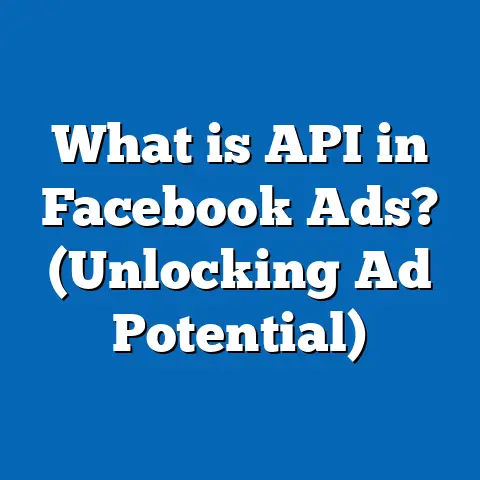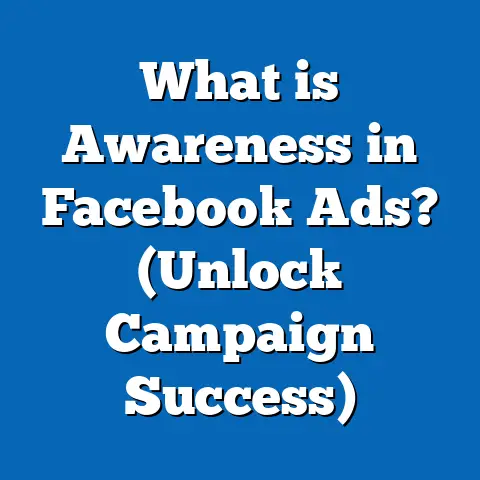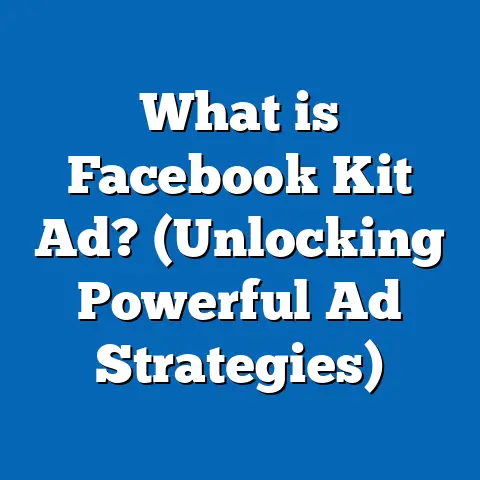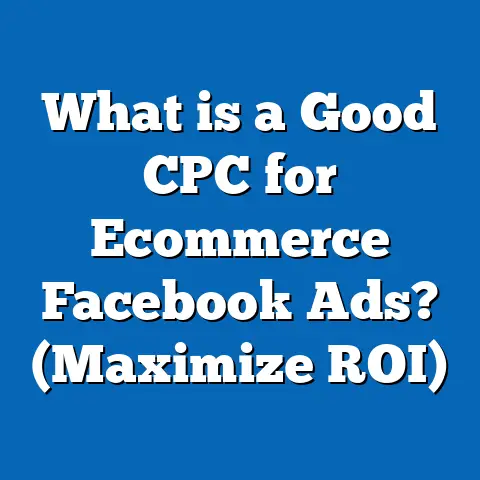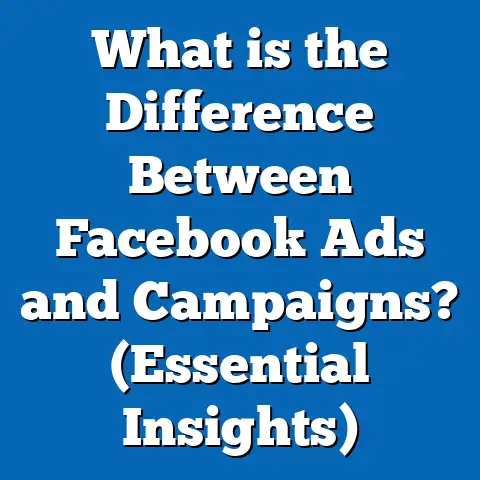What is the Best Facebook Ad for E-commerce? (Expert Tips)
What is the Best Facebook Ad for E-commerce? (Expert Tips)
Introduction: The Paradox of Facebook Ads for E-commerce
Facebook ads are omnipresent in today’s digital marketing landscape, yet many e-commerce brands find themselves stuck in a frustrating loop. Despite Facebook boasting over 2.96 billion monthly active users worldwide, countless businesses report mediocre or poor results from their campaigns. How can a platform with such a vast audience and powerful targeting tools produce such inconsistent outcomes?
Understanding the Facebook Advertising Landscape for E-commerce
The Scale and Reach of Facebook Advertising
Facebook’s advertising platform remains one of the most influential in the digital ecosystem. In 2023:
- Facebook accounted for over 23% of global digital ad spend, with total revenue exceeding $140 billion.
- E-commerce sales attributed to Facebook ads globally reached approximately $55 billion.
- Over 70% of consumers globally reported discovering new brands through social media ads, with Facebook leading this trend.
This massive scale presents both opportunity and challenge — the opportunity to reach highly specific audiences at scale and the challenge of competition and rising ad costs due to saturation.
Why Facebook Ads Work Exceptionally Well for E-commerce
Facebook’s success with e-commerce advertising lies in its sophisticated targeting and versatile ad formats:
- Precision Targeting: Advertisers can zero in on users based on demographics (age, gender), location (country, city), interests (fitness, fashion), behaviors (purchase habits), and online activity.
- Custom Audiences: Remarketing to people who have visited your website or engaged with your brand ensures relevance.
- Lookalike Audiences: Reach new potential customers who mirror your best existing buyers.
- Multi-format Ads: From images to videos, carousels to dynamic product ads, Facebook offers diverse ways to showcase products.
This enables e-commerce businesses to deliver personalized experiences that align with user intent and stage in the buying journey.
The Role of Mobile in Facebook E-commerce Ads
Mobile devices dominate Facebook usage:
- Over 98% of Facebook users access the platform on mobile devices.
- Mobile commerce accounts for nearly 73% of total e-commerce sales driven by social media ads.
- Facebook’s mobile-first design favors ads that are visually engaging and quick to load.
For e-commerce advertisers, optimizing ads for mobile viewing is critical to capture attention and reduce bounce rates.
Types of Facebook Ads Best Suited for E-commerce
1. Dynamic Product Ads (DPA)
Dynamic Product Ads automatically show users products they’ve shown interest in or related items based on their browsing behavior.
How DPAs Work
DPAs connect your product catalog to Facebook’s ad system. When a user visits your e-commerce site and views specific products but does not purchase, DPAs automatically serve ads featuring those exact items or similar ones across Facebook and Instagram.
Benefits
- Personalization: Ads are tailored to individual user behavior.
- Higher Conversion Rates: Studies show DPAs generate 70% higher conversion rates compared to static retargeting ads.
- Efficiency: Automates retargeting at scale without manual creative updates.
Practical Application
A user looks at a pair of headphones but leaves without buying. A DPA retargets them with an ad showing those headphones alongside accessories like cases or cables, often coupled with a discount offer.
2. Carousel Ads
Carousel ads allow displaying multiple images or videos within one ad unit that users can swipe through.
Why Carousel Ads Work Well for E-commerce
- Provide space to showcase several products or multiple features.
- Tell a story across sequential cards (e.g., product benefits, customer reviews).
- Engage users through interactive content that encourages exploration.
Data Insights
- Carousel ads see a 30-50% higher click-through rate than single-image ads.
- They can reduce cost per click (CPC) by up to 20% due to better engagement.
Example Use Cases
- Clothing retailers showcasing a full outfit lineup.
- Electronics brands displaying various product models or bundle deals.
- Home décor shops presenting room designs featuring multiple items.
3. Collection Ads
Collection ads combine video or images with product catalogs in a fullscreen shopping experience optimized for mobile devices.
Features and Advantages
- Users can browse multiple products without leaving Facebook.
- Integrates storytelling (video or lifestyle images) with easy product discovery.
- Reduces friction in the purchase path by streamlining browsing and buying on mobile.
Effectiveness
Retailers using collection ads report:
- A 20% increase in purchase intent.
- Higher engagement times with ads compared to static formats.
Real-world Example
A beauty brand launches a new skincare line using a collection ad that opens with a tutorial video demonstrating product use. Below the video, clickable product tiles allow direct purchase.
4. Video Ads
Video ads are among the most effective formats for storytelling and demonstrating product value.
Importance of Video for E-commerce
- Videos increase emotional connection with brands.
- They improve message retention and highlight product features clearly.
- Can be short (15 seconds) or longer explainer videos depending on audience attention span.
Key Statistics
- Facebook video ads have an average engagement rate of 6.15%, which is nearly double that of image ads.
- Videos generate a 120% increase in organic shares compared to images.
Best Practices
- Capture attention within the first 3 seconds.
- Show product benefits in real-life scenarios.
- Add subtitles since many users watch videos on mute.
5. Lead Ads
Lead ads are designed to collect user information directly within Facebook via forms without redirecting users elsewhere.
Why Use Lead Ads in E-commerce?
- Capture emails for newsletters or exclusive offers.
- Collect sign-ups for pre-launch events or limited-time deals.
- Reduce friction by keeping users on the platform.
Use Cases
A brand launching a new product line might use lead ads to build anticipation by offering early access in exchange for email sign-ups.
Crafting the Best Facebook Ad for E-commerce: Expert Tips
1. Deep Audience Understanding is Non-negotiable
Before creating any ad, you must know who you are talking to:
- Use Facebook Audience Insights to gather detailed data on demographics, interests, behaviors.
- Segment your audience into stages:
- Awareness: New users unfamiliar with your brand.
- Consideration: Users who have engaged or visited your website.
- Decision: Ready-to-buy customers or cart abandoners.
Tailor messaging and creatives accordingly.
2. Visuals Matter More Than Ever: High Quality is Essential
Your ad’s image or video is the first thing users notice:
- Use high-resolution images that show products clearly.
- Avoid stock photos that look generic; original content builds trust.
- For videos, ensure good lighting, clear audio, and professional editing.
Visuals should communicate product benefits instantly—whether that’s style, functionality, or emotion.
3. Social Proof Builds Instant Credibility
Modern consumers want validation before purchasing online:
- Include testimonials or star ratings in your ad copy or creative.
- Highlight customer reviews or user-generated content (UGC).
- Show numbers if possible (“Over 10,000 happy customers!”).
Social proof can reduce hesitation and increase conversion likelihood.
4. Craft Compelling Ad Copy with Clear Calls-to-Action (CTAs)
Effective copy balances brevity with persuasion:
- Start with a hook that addresses pain points or desires.
- Highlight unique selling points (free shipping, discounts, warranty).
- Finish with a strong CTA aligned with your goal: “Shop Now,” “Claim Your Discount,” “Learn More.”
Avoid jargon or vague CTAs like “Click Here” — make it relevant and action-oriented.
5. Always Test Multiple Variables Through A/B Testing
Testing is critical because what works for one brand may not work for another:
- Test different headlines, images/videos, CTAs, and offers.
- Experiment with audience segments and placements (Facebook feed vs stories vs Instagram).
- Monitor key metrics like CTR, conversion rate, CPA closely.
Once you identify winning variables, scale those campaigns while pausing ineffective ones.
Advanced Strategies for Maximizing E-commerce Facebook Ads ROI
Leveraging The Power of Facebook Pixel for Tracking & Retargeting
The Facebook Pixel is essential for data-driven advertising success:
- Tracks user actions on your site (views, adds-to-cart, purchases).
- Enables retargeting campaigns tailored to specific behaviors.
- Provides conversion data that helps Facebook optimize ad delivery automatically.
According to industry reports:
Advertisers using the Pixel experience up to a 40% reduction in cost per acquisition compared to those who don’t use it.
Proper implementation involves placing Pixel code on all key pages and setting up standard/custom events aligned with your sales funnel.
Implementing Campaign Budget Optimization (CBO)
Campaign Budget Optimization lets Facebook allocate spend across ad sets based on performance in real time:
- Saves manual oversight time while improving efficiency.
- Ensures budget flows towards best-performing audiences and creatives automatically.
Research shows brands using CBO see up to 25% improvement in ROAS compared to manual budget allocation methods.
Utilizing Advantage+ Shopping Campaigns (AI-Powered Automation)
Facebook’s Advantage+ Shopping Campaigns use AI to automate targeting and creative combinations:
- Great for smaller e-commerce businesses wanting fast scaling.
- The algorithm tests multiple creative versions and audiences simultaneously.
Retailers switching to Advantage+ report an average 30% increase in ROAS due to improved optimization speed and accuracy.
Custom Audiences & Lookalikes: Beyond Basics
Creating custom audiences from your website visitors or customer lists allows hyper-focused retargeting:
- Segment by behavior: recent visitors vs cart abandoners vs past purchasers.
Lookalike audiences replicate your best customers’ profiles and expand reach efficiently:
- Set lookalikes at 1% similarity initially for highest precision.
Combining custom audiences and lookalikes boosts campaign relevance dramatically.
Case Studies: Successful E-commerce Campaigns on Facebook
Case Study 1: Fashion Brand Drives 150% Sales Growth Using Dynamic Product Ads
A mid-level fashion retailer integrated DPAs into their retargeting strategy:
- Targeted users who viewed products but didn’t buy.
- Optimized creatives featuring lifestyle images plus discount offers.
Results after 3 months:
| Metric | Before DPAs | After DPAs |
|---|---|---|
| Sales Volume | Baseline | +150% |
| Cost per Acquisition (CPA) | $45 | $29 (-35%) |
| Return on Ad Spend (ROAS) | 3x | 5x |
This confirmed the power of personalized dynamic ads in recapturing lost sales efficiently.
Case Study 2: Beauty Brand Uses Video & Collection Ads for New Product Launch
A beauty company launching a skincare line combined video tutorials with collection ads featuring clickable products:
Results:
- Engagement rate increased by 45%.
- Conversion rate jumped by 20% on launch day relative to previous launches.
- Email list grew by 15% from integrated lead forms.
This multi-format approach created immersive storytelling with smooth shopping experiences boosting both awareness and sales.
Case Study 3: Electronics Retailer Reduces CPA by 30% Using CBO & Advantage+ Campaigns
An electronics seller tested manual budget allocation against CBO combined with Advantage+ automated campaigns:
| Metric | Manual Budget | CBO + Advantage+ |
|---|---|---|
| CPA | $75 | $52 (-30%) |
| ROAS | 3x | 4x |
| Conversion Rate | 4% | 6% |
Automation reduced manual work while improving targeting precision and ad delivery efficiency.
Comparing Facebook Ads With Other Advertising Platforms for E-commerce
| Platform | Strengths | Weaknesses | Ideal Use Cases |
|---|---|---|---|
| Highly precise targeting; versatile formats; vast audience | Increasing competition; rising CPM | Broad targeting & retargeting | |
| Visual storytelling; influencer integration | Higher CPM; younger audience bias | Fashion, beauty, lifestyle brands | |
| Google Shopping | High intent purchase traffic; search-driven | Limited audience targeting; less brand storytelling | Search-based product sales |
| TikTok | Viral potential; younger demographic | Less mature ad tools; less precise targeting | Trendy products; brand awareness |
| Strong purchase intent; niche interests | Smaller audience size | Home décor; fashion; DIY |
Facebook offers unmatched balance between audience size, targeting depth, diverse creative options, making it indispensable in e-commerce marketing mix.
Key Performance Metrics Every E-commerce Advertiser Should Track on Facebook
To optimize campaigns effectively, monitor these core KPIs regularly:
| Metric | What It Measures | Why It Matters |
|---|---|---|
| Click-through Rate (CTR) | % of people who click your ad | Measures ad relevance & appeal |
| Conversion Rate | % of clicks that lead to purchase | Shows effectiveness of landing page & offer |
| Cost Per Acquisition (CPA) | Average spend per sale | Determines campaign profitability |
| Return on Ad Spend (ROAS) | Revenue generated per dollar spent | Measures overall campaign efficiency |
| Average Order Value (AOV) | Average sale amount per order | Indicates purchase quality |
| Frequency | Average number of times an individual sees an ad | Helps avoid ad fatigue |
Consistent monitoring allows timely adjustments that improve ROI over time.
Technical Concepts Explained Simply for Marketers
What Is Facebook Pixel?
A small piece of code added to your website that tracks visitor actions like:
- Page views
- Add-to-cart events
- Completed purchases
This data helps create better audiences for retargeting and allows Facebook’s AI to optimize ad delivery toward people most likely to convert.
What Is Campaign Budget Optimization (CBO)?
Instead of setting fixed budgets per ad set manually, CBO lets you assign one overall campaign budget. Facebook’s algorithm then allocates funds dynamically across ad sets based on real-time performance signals — maximizing efficiency without constant manual oversight.
How Do Lookalike Audiences Work?
Facebook analyzes your source audience’s demographics, interests, and behaviors then finds new people similar to them across its user base. This helps expand reach precisely beyond existing customers without guesswork on targeting parameters.
Practical Steps To Create Your Best E-commerce Facebook Ad Today
- Set Clear Goals: Define what you want—brand awareness? Sales? Leads?
- Install & Configure Pixel: Essential for tracking & retargeting success.
- Build Relevant Audiences: Use custom & lookalike audiences segmented by funnel stage.
- Choose Ad Format Based on Goal:
- Awareness: Video or carousel
- Consideration: Collection or carousel
- Conversion: Dynamic product ads
- Design High-quality Visuals & Write Clear Copy: Focus on benefits + strong CTA.
- Launch A/B Tests: Test creatives, copy & targeting simultaneously.
- Monitor Metrics Daily: Adjust budget & creatives based on performance data.
- Scale Successful Campaigns: Increase budget gradually while maintaining ROI.
- Experiment With New Features: Try Advantage+ Shopping campaigns or new placements like Reels.
- Keep Learning & Adapting: Stay updated on algorithm changes & best practices.
Latest Trends and Features Impacting Facebook Ads for E-commerce in 2025
Rise of AI-Powered Creative Optimization Tools
New tools automatically generate multiple creative versions using AI based on your brand assets — making testing faster and less resource-intensive.
Integration With Meta Shops & Instagram Shopping
Seamless shopping experiences inside Meta apps reduce friction from discovery to purchase without leaving the platform altogether.
Increased Focus on Privacy & Data Protection
With changes like iOS privacy updates limiting tracking capabilities, advertisers are shifting toward first-party data strategies combined with contextual targeting over invasive tracking methods.
Growing Popularity of Short-form Video Ads (Reels)
Short-form vertical videos now outperform traditional formats on engagement metrics across Facebook and Instagram feeds.
Summary: Key Takeaways To Master Facebook Ads for E-commerce
- The best e-commerce Facebook ads are highly personalized using dynamic formats like DPAs combined with engaging visuals such as videos or carousels.
- Deep audience understanding through segmentation plus pixel-based data is essential for targeted messaging.
- Testing multiple creatives & targeting variables continuously is vital given marketplace dynamism.
- Advanced features like CBO, Advantage+ campaigns leverage AI automation improving cost-efficiency significantly.
- Keep mobile optimization top-of-mind since most users interact via smartphones.
- Monitor KPIs diligently and act quickly on underperforming ads while scaling winners responsibly.
By applying these expert insights supported by data and real-world examples, you can turn Facebook advertising into a scalable revenue engine for your e-commerce business — breaking free from the paradox of wasted spend into consistent profitable growth.

